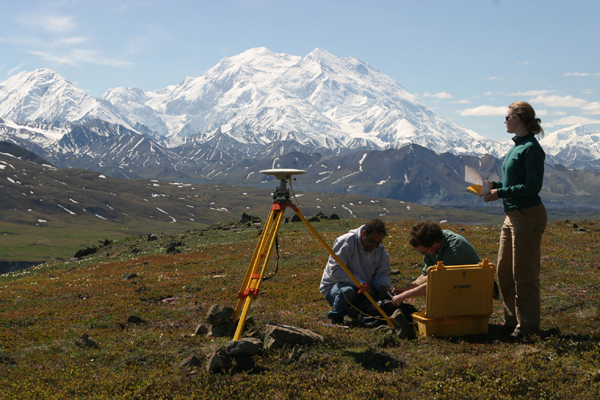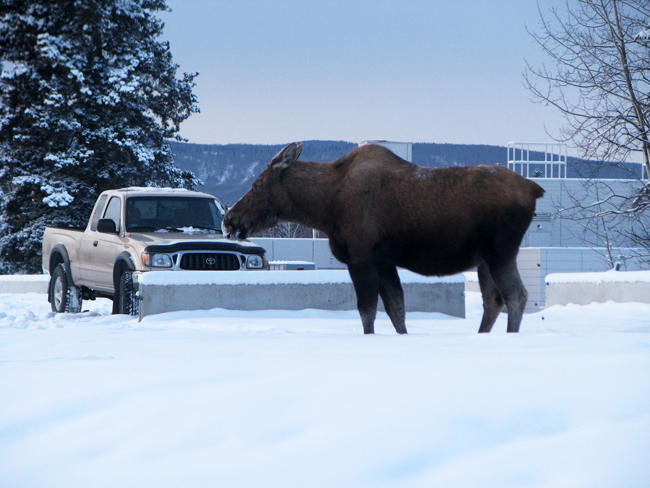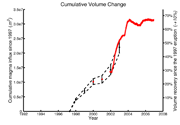 Former UAF graduate students Samik Sil, Tom Fournier and Kelly Kore set up a GPS site in
Denali National Park, with a great view of the highest peak in North America.
Photo copyright (c) 2004 Russ Gutshall,
used by permission.
Former UAF graduate students Samik Sil, Tom Fournier and Kelly Kore set up a GPS site in
Denali National Park, with a great view of the highest peak in North America.
Photo copyright (c) 2004 Russ Gutshall,
used by permission.
Come work in Alaska!
Opportunities are now available for graduate study in the exciting field of crustal deformation. Our group uses precise geodetic and other techniques to study the motions and deformation of the solid earth: plate motions, deformation due to active tectonics, earthquakes, aseismic fault slip events, and the deformation associated with active volcanoes. Exciting new data sets are available from the EarthScope Plate Boundary Observatory, and from growing continuous GPS networks on Alaska volcanoes deployed by the Alaska Volcano Observatory. Opportunities are available for one or more new graduate students.- What kind of work do we do?
- Current Projects
- What is it like to live in Fairbanks, Alaska?
- Application information
- How to contact me
- Current Projects
What kind of work do we do?
The earth's crust is constantly in motion. My research focuses on making measurements of active motions and deformations of the crust, and in relating those measurements to their source processes. We use geodetic techniques for this work, mainly a satellite-based positioning system called the Global Positioning System (GPS). GPS is an amazing tool which lets us study all sorts of tectonic processes ranging from global plate motions to deformation associated with individual fault zones. In essence, we measure crustal motion by making ver precise measurements of the positions of sites, and then repeating those measurements over a period of years. When we start to study a new area where no data was ever taken before, we get a hint of what is going on after one year, a fairly good idea after two, and a really precise measurement after 3-4 years. How soon results are significant depends on the rate of the process we are trying to measure. Also, in quite a few places there is some pre-exisiting data which allows us to get interestig results without waiting for years.
We do a lot of fieldwork. Every summer there will be opportunities to travel to various parts of Alaska and other places with a GPS receiver. Although we always work hard in the field, there is always some time to enjoy the places and the scenery. In addition to fieldwork there is data analysis and modeling in the office. GPS data analysis is getting easier all the time, and students here get plenty of expert guidance to help them learn.
We make extensive use of the new National Science Foundation-sponsored Plate Boundary Observatory (PBO), which has installed about 150 new continuous GPS sites across Alaska.
We also use another space geodetic technique, Interferometric Synthetic Aperture Radar (InSAR). InSAR uses multiple passes of a satellite-borne radar to measure topography and deformation. This technique has a lot of promise, especially for measuring deformation which occurs rapidly, due to earthquakes or volcanic eruptions. It is less clear whether it will be useful in general for slow deformation of the earth, but in certain enviroments (deserts, for example) it has already been used to measure such motions.
Current Projects
A brief list of our active, proposed, nad recently completed projects is given below. The hyperlinks will take you to pages which describe the projects in more detail. These should give you a feel for the kind of work we do. Please note that several of these pages are most definitely under construction. Please feel free to contact me directly if a project seems interesting but the details on the Web are skimpy.- Tibet and the India/Eurasia Collision Zone
- Deformation of Alaska Volcanoes and Alaska Volcano Observatory
- PIRE Kamchatka: Bezymianny Volcano
- St. Elias Erosion and Tectonics Project
- Subducted Terranes Beneath North America
- Glacial-Isostatic Adjustment and Hydrological Loading in SE Alaska
- Postseismic Deformation Following the 2002 Denali Fault Earthquake
- Motion of the Bering Plate
What is it like to live in Fairbanks, Alaska?
I grew up in southern California, and have lived in California, Hawaii and South Carolina. All of those places have something in common: they are hot places! Alaska is not. When I came up here, I knew I would like my job but I didn't know if I would like Alaska, but I found that this is a really good place to live. I don't really mind the winter. There is a LOT of outdoors in Alaska, and wilderness is not far from your home. Hunting and fishing opportunities abound, plus hiking, rock climbing, mountaineering, etc.
Fairbanks is a small town, with a nominal population of 40,000 or so, and maybe 80,000 in the area (within 1 hour's drive). The population is an interesting mix of University, military, government employees, and assorted types, including a variety of Alaskan oddballs. We have all of the major elements of American civilization, and if you want to see a city, Anchorage is just a 45 minute flight or 7 hour drive away (or 12 hours on the Alaska Railroad through Denali National Park and other scenic spots).
Summers are short and frenzied. It never gets dark between May and August, and you can find some kind of outdoor activity almost 24 hours a day. Yes, we have some bugs, but they are usually tolerable ("Off!" is the official perfume of Alaska). Spring and Fall are the most beautiful times, featuring an incredible burst of plant growth and stunning golden colors respectively. Winter is about half the year, but most people view it as an opportunity to slide around and have some fun. There are about 2 months where only the hardcore skiers will be out, but the rest of the time is great for winter sports. We have excellent cross-country skiing and a couple of downhill runs. Plus snowmachining, dog mushing, etc.
In short, if you like to be outdoors, it is hard to imagine a better place.
Moose on the Loose!
What would Alaska be without the magnificent moose?

February 13, 2009
TO: UAF staff and faculty
FROM: Police Chief Sean McGee
SUBJECT: Moose on campus
This is a reminder that moose living near the University of Alaska Fairbanks may pass through campus. Members of the campus community should use common sense if they come in contact with wildlife and be aware that wildlife could be present, especially in the wooded areas of campus.
Do not attempt to feed wild animals or try to approach them....

Application information
To apply for graduate school at the University of Alaska Fairbanks, you will need to contact the Department of Geology and Geophysics. Application information and many of the necessary application forms are available on their Web page. You can also contact the Department through their web page to request an application packet. We have graduate programs in both Geology and Geophysics; students interested in working with me should apply to the Geophysics program, and need to be have the right preparation for that program. If you are a geologist who has taken very little math and physics, but has come to realize that the motion and deformation of the earth is a really exciting topic, then you will need to make up some deficiencies before you will really be ready for our program or for this line of research.If you do apply for admission, please send me an email message so that I will know you saw this page, and so that I will be alerted to take special notice of your application.
How to contact me
Feel free to contact me for more information. Click on my name below to go to my personal web page, or on my email address to send me email.Dr. Jeffrey T. Freymueller
Professor of Geophysics
Geophysical Institute
University of Alaska, Fairbanks
Fairbanks, AK 99775-7320




